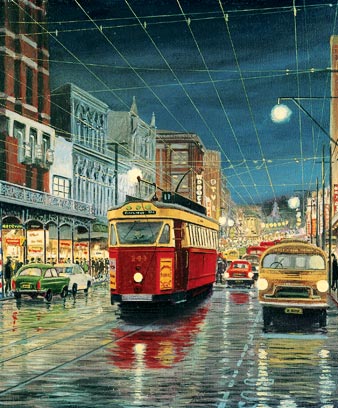Story summary
First streets
In the first New Zealand towns people made their own streets. 19th century streets were often just dirt tracks, muddy in winter and dusty in summer. In 1853 the government set up town and roads boards, and would go halves with locals to pay for street paving.
Most towns were laid out in a grid pattern, and everything stayed within walking distance. Streets got narrower as more and more houses were built in the grid.
After 1867 the government had rules about the width of streets, and engineers had to approve street plans. But land developers were often on the local council, and approved their own substandard streets.
Street paving
Streets were paved with macadam, a mixture of small stones and clay. This suited horse-drawn vehicles, but when cars took to the road in the 1920s they were too heavy and fast and damaged the paving.
Macadam was slowly replaced with wood-block paving or asphalt. Wood-block paving was cheaper because local workers could lay it – asphalt was laid by skilled contractors.
The economic depression in the 1930s reduced funds for building streets, although unemployed men were put to work making new streets. During the Second World War most spending on streets stopped, but from the 1950s many streets were rebuilt and new ones made. In the 1960s urban motorways were built in Auckland and Wellington, running through central historic areas.
By the early 2000s most streets were sealed with asphalt. The New Zealand Transport Agency controlled government funding for streets.
Verandahs
Many New Zealand shops had verandahs over footpaths, held up by poles. Some roofs were made of glass to let in light. Verandahs provided shelter from the sun and the rain.
At first people thought they looked higgledy-piggledy. If the poles were hit by traffic they could collapse. Councils soon required verandahs to be attached to the building only. They became covered in advertising signs. But people appreciated being able to walk from shop to shop regardless of the weather.
Street lighting
Unless the moon was shining it was hazardous to travel after dark on early streets. People fell into streams or sewers or banged into animals. There were candle lamps outside hotels, but the light was feeble. From the 1860s kerosene lamps were hung near hazards like drains or at the edge of bridges, but streets were dimly lit.
The first system of street lighting used gas lamps. By 1876 Christchurch had 152. At first they were lit by hand, but then pilot lights were introduced. Over time electricity replaced gas, though Christchurch had gas lighting until 1903.
Electric lamps have become brighter and more energy-efficient. In 2009 there were over 330,000 street lights in New Zealand, running for 4,000 hours and using $18 million worth of electricity in total. People were exploring ways to make street lights use less power.





